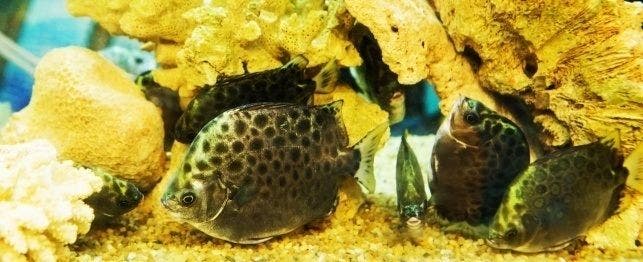
Choosing a Scat
The scat, Scatophagus argus, is an unusual surprise to the hobbyist in it’s coloration and appearance. Scats are members of the family of butterflyfishes and are found in coastal waters and estuaries of the Indo-Pacific. As juveniles, they live in both fresh and brackish water. Brackish is a term that refers to the water in areas where rivers flow into oceans. The water has a higher salt content than fresh but lower than that of sea water and is typically murky. As they mature, the adults usually make their home in saltwater. The scat’s Latin name, Scatophagus argus, literally means “feces eater” and is derived from its habit of eating the waste of other fish.
Appearance and Behavior
The scat is a beautiful fish with a disc shaped body that is a greenish silver color covered with numerous black spots. There is some red coloration to the fins, more prominent in the juveniles. In their native habitats, they may reach a length of 10 inches to 12 inches, although 3 inches to 6 inches is more common in the home aquarium. Scats are active but peaceful and will be observed investigating the bottom of the tank, rocks and decorations for food morsels. Once they come to anticipate scheduled feeding times, they are often first to the surface awaiting food. Despite their beautiful markings, scats hang out in murky, dirty water in the wild where they are active scavengers. In the aquarium, they quickly adjust to a variety of foods with a minimum of difficulty.
Feeding and Tank Requirements
If your fish are healthy, they will accept a wide variety of foods. Scats have been observed to have a fondness for frozen peas. You may want to offer a few small ones, or make a mash and freeze it and offer it in small pieces. Beef heart, fish, brine shrimp, frozen and freeze dried foods are all accepted.
If you are keeping your fish in saltwater, average tank conditions are adequate. To create a brackish environment for younger fish or those not yet acclimated to saltwater, add a tablespoon of aquarium salt to a gallon of water or salt mix to a specific gravity of 1.010 to 1.015. Keep the temperature between 74 to 80 degrees Fahrenheit. When you acquire your scats, make sure and ask your supplier whether they have been kept in a fresh, brackish or saltwater environment. Try to reproduce those conditions before making any changes.
Special Concerns
If it becomes necessary to handle your scat, be cautious of the spiny dorsal fin. The spines contain a mild venom that can cause tingling or pain for 15 to 20 minutes.
Just because scats like to hang out in murky water doesn’t mean you should try and reproduce those conditions in your tank, neglecting normal cleaning. By providing a consistent food source, scats will do very nicely in your well-maintained and filtered aquarium. If you want to try a few brackish water companions, try adding a mono or a target fish.